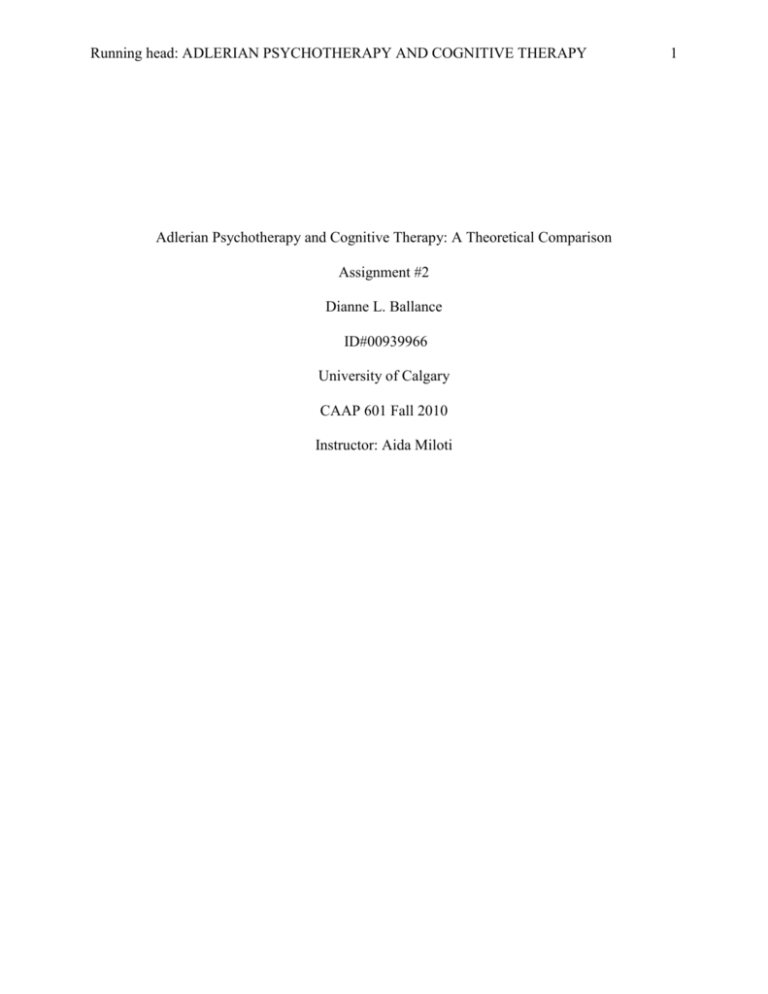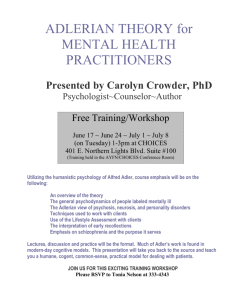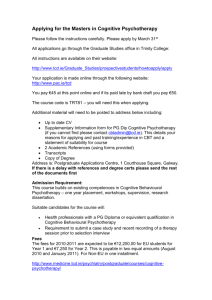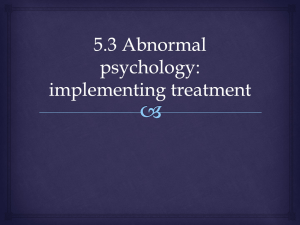Adlerian Psychology & Cognitive Therapy
advertisement

Running head: ADLERIAN PSYCHOTHERAPY AND COGNITIVE THERAPY Adlerian Psychotherapy and Cognitive Therapy: A Theoretical Comparison Assignment #2 Dianne L. Ballance ID#00939966 University of Calgary CAAP 601 Fall 2010 Instructor: Aida Miloti 1 ADLERIAN PSYCHOTHERAPY AND COGNITIVE THERAPY 2 Adlerian Psychotherapy and Cognitive Therapy: A Theoretical Comparison This paper will explore a theoretical comparison of Adlerian Psychotherapy (AP) and Cognitive Therapy (CT) within the framework of The Nature of Theory commentary through discussion of the philosophical, descriptive, prescriptive, and evaluative theory elements. These theories were chosen on the basis of personal preference of areas of interest as well as an effort to further understand both historical and contemporary influences in counselling psychology. Adlerian psychotherapy may be considered as an early contributor to the field of psychology that influenced the development of contemporary theories and approaches to counselling and psychotherapy (Watts, 2003). Adlerian psychology is also referred to as Individual Psychology, and was developed by Alfred Adler circa 1931 (Mosak & Maniacci, 2011; Shifron, 2010). Contemporary practice of Adlerian therapy focuses on a cooperative, psychoeducational, present/future oriented, and a brief or time-limited approach (Mosak & Maniacci, 2011; Watts, 2003). This theory appealed to me in that it highlights a positive viewpoint of human nature, and considers both the social context and a holistic stance in regards to the understanding and counselling of individuals (Mosak & Maniacci, 2011). I was interested in developing my knowledge of Adlerian psychology as I feel it strongly relates to my future work as a school psychologist, and how we view the broader social environment of schools and communities. Cognitive Therapy as developed by Aaron T. Beck is a widely used therapy in mental health settings, and is the dominant clinical approach (Sperry, 2003). Cognitive therapy is a collaborative problem solving approach that recognizes the influence of cognitive, affective, motivational, and behavioural responses in human perception and learning (Beck & Weishaar, 2011). I am familiar with how cognitive therapy can be modified within an educational setting ADLERIAN PSYCHOTHERAPY AND COGNITIVE THERAPY 3 in my experience in providing interventions for children (behavioural and academic), and was interested in developing a more detailed understanding of the theoretical foundations of this theory and how it is applied in both counselling and educational psychology. The Philosophical Element Theoretical Assumptions The AP viewpoint is broad and holistic in nature, and includes intrapsychic, interpersonal, relational and environmental factors (Dowd, 2003; Mosak & Maniacci, 2011; Osborn, 2001; Sperry, 2003; Watts, 2000). Adlerian psychotherapy is concerned with early life and systemic factors, including family, peer, and social dynamics (Shifron, 2010; Sperry, 2003, 2009). Adlerian psychotherapy views humans as embedded within the social context in which one is raised and lives (Freeman & Urschel, 2003; Shifron, 2010; Watts, 2000). Difficulties are viewed as social problems that involve human interconnectedness and a sense of belonging (Freeman & Urschel, 2003; Shifron, 2010). Social interest is created first with the relationship between mother and child, and continues through cooperation as children extend themselves beyond this relationship (Freeman & Urschel, 2003). Children who are fortified with the realization that early relationships are dependable, warm, and sensitive will develop identification with family, peers, and the larger community in a healthy lifestyle (Freeman & Urschel, 2003). Children’s perceptions of family constellation and their place within the family system contribute to their personality development (Mosak & Maniacci, 2011). Adlerian psychotherapy emphasizes that human behaviour is purposive, goal-directed, and future-oriented, which is referred to as the teleological principle; therefore AP is anticipatory in nature (Dowd, 2003; Sperry, 2009; Watts, 2000). Humans are conceptualized as active agents from a dynamic and structural view, and have aspects that are known and unknown (Maniacci, ADLERIAN PSYCHOTHERAPY AND COGNITIVE THERAPY 4 2003; Watts, 2000). Individuals are viewed holistically, creative, responsible, and moving towards goals (Mosak & Maniacci, 2011; Sperry, 2009; Watts, 2000). Psychopathology in individuals is viewed as forms of self-defeat or “basic mistakes” due to discouragement or inferiority feelings rather than a‘sickness’ (Mosak & Maniacci, 2011; Watts, 2000). Central values of AP are encouragement and democracy in therapy as well as in consultation and in education (Sperry, 2003). Cognitive therapy is mostly intrapsychic in nature, although it does allow for the appreciation of behaviour in a social context and recognition of the role of early relationships in schema (Beck, 2005; Dowd, 2003; Neimeyer). Core cognitive schemas direct behaviour and are motivated by past consequences; therefore CT is consequential in nature (Dowd, 2003). The self is placed at the centre of control in CT (Maniacci, 2003). Cognitive distortions and deficits are the processes that influence pathology, perceptual errors, and faulty interpretations (Mosak & Maniacci, 2011). Individual learning influences an individual’s cognitive system to deal with perceptions, interpretations, and meaning of events (Beck & Weishaar, 2011). Both AP and CT have similar assumptions about human nature that reflects an underlying rational philosophy of mind and the ability of individuals to make choices (Shifron, 2010; Sperry, 2003). Individual’s assumptions about self and the world govern motivation, behaviour and attitudes, and are formed early in life; although individual’s may not be aware of these underlying beliefs (Freeman & Urschel, 2003; Mosak & Maniacci, 2011). Adlerian psychotherapy refers to early recollections as creating these assumptions, and CT refers to first perceptual processes that integrate emotions and needs, to form these beliefs and schemas (Freeman & Urschel, 2003). Cognitive structures are therefore the common element in creating the AP lifestyle and the CT schema (Mosak & Maniacci, 2011). The notion of the unconscious ADLERIAN PSYCHOTHERAPY AND COGNITIVE THERAPY 5 is addressed by AP through inferred concepts such as guiding fictions, lifestyle analysis, realm of meanings and the teleological principle (Dowd, 2003). The unconscious in AP is what is not understood, although it contributes to individual’s goals in addition to the conscious (Mosak & Maniacci, 2011). Cognitive therapy has also incorporated some aspects of the unconscious in terms of processing and knowledge in terms of implicit and tacit knowledge, and primal thinking; although CT maintains that dysfunctional schemas are not deeply buried in the unconscious (Beck & Wesishaar, 2011; Dowd, 2003). The Descriptive Element Human Nature In AP, individuals develop their own life stories that organize the content of their experience, and their personality is a unity or integrated whole (Neimeyer, 2003). Cognitive organization, private logic, and perceptions contribute to the formation of convictions early in life, and the development of a lifestyle in how they perceive life (Mosak & Maniacci, 2011; Stein, 2008). Distortions and symptoms are selected as they are perceived as facilitating goals, and compensations are attempts at safeguarding lifestyle convictions (Neimeyer, 2003). Individuals are motivated by self-selected goals (rather than heredity and environment) and are involved in an ongoing process of self-realization and self-actualization through life tasks (Mosak & Maniacci, 2011). In AP, healthy individuals have developed social interest and are committed to life-tasks through a useful and healthy lifestyle (Mosak & Maniacci, 2011; Osborn, 2001). The human potential and creative power are key elements of AP (Osborn, 2001; Stein, 2008; Watts, 2000). Cognitive therapy views personality as shaped by interactions between innate disposition and environment, and emphasizes the role in information processing in human responses and ADLERIAN PSYCHOTHERAPY AND COGNITIVE THERAPY 6 adaptation that are crucial in individual’s lives and how they function (Beck & Weishaar, 2011; David & Szentagotai, 2006). Individuals respond to situations cognitively, emotionally, motivationally, and behaviourally through a set of schemas (Beck & Weishaar, 2011; Weinrach, 1988). In CT, early negative experiences are the developmental precursors for negative schemas regarding the self, current circumstances, and the future; however, there is little recognition of early life determinants including birth order, family constellation, or personality that are included in AP (Sperry, 2003). Cognitive schemas contain people’s perceptions of self and the world, goals and expectations, memories, and previous learning (Beck & Weishaar, 2011; Dowd, Clen, & Arnold, 2010). Schemas that are strongly held are seen to be essential for individual’s safety and well-being will be a more powerful and directing force within a person’s life (Freeman & Urschel, 2003). Schemas are self-selective in an active and evolutionary process in which all perceptions and cognitive functions are applied to new functions. Schemas are central to psychopathology, and those schemas that distort reality, fail to fit new circumstances, accommodate new structures, or create distortions would be maladaptive and considered cognitive shifts or vulnerabilities and generate problems (Beck & Weishaar, 2011; Freeman & Urschel, 2003; Dowd et al., 2010; Neimeyer, 2003). CT sees pathology as a consequence of a number of factors that include learning history, biological, developmental, and environmental influences (Beck, 2005; Beck & Weishaar, 2011). The individual is free to choose alternative lifestyles and schemas in both theories (Beck & Weishaar, 2011; Mosak & Maniacci, 2011). Process of Therapy The main therapeutic focus in AP is lifestyle convictions, while schemas are the focus of CT. Essentially these constructs comprise cognitive organization and perceptions of the individual, and describe their convictions or beliefs about the self and the world (Sperry, 2003). ADLERIAN PSYCHOTHERAPY AND COGNITIVE THERAPY 7 Both are dynamic therapies that help individuals listen and understand their thinking, and appraise how thinking is influenced by lifestyle and schema. Both AP and CT examine how individuals perceive self and their world, and experiment with different ways of responding to alter negative affect, change their view of life experience, and behave more adaptively (Freeman & Urschel, 2003). Differences between AP and CT are greatest in consideration of strategies and technical implementation of the theories (Freeman & Urschel, 2003). The therapeutic relationship in both AP and CT is a collaborative one (Sperry, 2003). Cognitive therapy refers to the therapeutic relationship as one that involves collaborative empiricism where the therapist and patient are co-investigators (Sperry, 2003). The therapist’s role in CT utilizes warmth, empathy, and genuineness to guide corrective experiences (Sperry, 2003). Adlerian psychotherapy is also essentially an exercise of cooperation, and considers a good therapeutic relationship to be a friendly one between equals (Sperry, 2003). AP is psychoeducational, present-future oriented, and time-limited in its approach to therapy (Watts, 2000). Cognitive therapy is a problem-focused, short-term, active, directive, collaborative, psychoeducational model of psychotherapy (Freeman & Urschel, 2003; Weinrach, 1988). CT offers a high degree of structure in which the therapist takes a directive role in treatment conceptualization, collaboration, and planning (Beck & Weishaar, 2011; Freeman & Urschel, 2003). Cognitive therapy has a beginning, middle, and an end; with goals for each stage that move from a symptom focus to a schema focus (Freeman & Urschel, 2003). Therapy addresses schemas from the cognitive, behavioural, situational, and affective perspectives (Freeman & Urschel, 2003). Interpretations are avoided in favour of Socratic questioning to encourage individual’s self-efficacy and greater awareness (Freeman & Urschel, 2003). The ADLERIAN PSYCHOTHERAPY AND COGNITIVE THERAPY 8 goal of CT is not cure, rather more effective coping; termination of therapy is accomplished gradually to allow for ongoing modifications and corrections (Freeman & Urschel, 2003). Context of Human Experience Adlerian psychotherapy supports equality between gender, culture, and race (Mosak & Maniacci, 2011; Watts, 2000). The social interest embedded with AP lends itself to community and global social issues, and has made significant contributions to education, hospital, and community therapies and programs (Mosak & Maniacci, 2011). Traditionally AP has demonstrated a willingness to undertake treatment for any individual ranging from individual and group therapy for a variety of pathologies (Mosak & Maniacci, 2011). The lifestyle assessment used in AP may contribute to a sensitive understanding of an individual’s family situation, values, interactions, social, cultural, and religious factors of development (Mosak & Maniacci, 2011). This lifestyle assessment allows AP therapists to learn about the individual and may provide a bridge between cultures (Mosak & Maniacci, 2011). The social nature of AP offers a wide range of benefits to humanity and promise for addressing multi-cultural issues (Stein, 2008; Watts, 2000). Cognitive therapy is best suited for individuals in which problems can be delineated and cognitive distortions are apparent (Beck & Weishaar, 2011). It has been widely used for a variety of psychiatric disorders alone or in combination with another form of psychotherapy. Traditionally CT was used on an individual basis, but is now used with couples, families, and groups (Beck & Weishaar, 2011). CT is not recommended as the inclusive treatment for individuals with some serious disorders and psychoses (i.e. bipolar, psychotic depression, schizophrenia) or when individuals are not currently stable (Beck & Weishaar, 2011; Weinrach, 1988). Individuals who have an adequate sense of reality, cognitive abilities (concentration, ADLERIAN PSYCHOTHERAPY AND COGNITIVE THERAPY 9 memory, etc.), and are motivated for therapy and change will benefit from CT (Beck & Weishaar, 2011). CT may be used for individuals with different levels of income, education, and background as CT begins with an understanding of the individual’s beliefs, values and attitudes that exist within multiple contexts including culture (Beck & Weishaar, 2011). The Prescriptive Element Nature of Change Adlerian psychotherapy can be described as optimistic in its assumption of the possibility of significant human change (Dowd, 2003; Stein, 2008). The beliefs and convictions that a person develops are what becomes the lifestyle, and direct individual’s movement through life towards goals (Freeman & Urschel, 2003). The basic aspect of selfhood is a unifying core construct, as is resistance and compensation (Freeman & Urschel, 2003). Adlerian psychotherapy focuses on the various aspects of the social system and not the individual in isolation, as such AP views individuals as constantly undergoing change as their cognitive systems interact with their environment (Dowd, 2003; Freeman & Urschel, 2003). Psychotherapy is considered one mechanism for potential creation of change within the context of AP. Change requires that individuals gain insight into perceptions and awareness of basic convictions and life styles (Neimeyer, 2003). Cognitive therapists focus on the dual levels of symptom structure and underlying schema structures, as the basis for understanding and changing individuals’ maladaptive patterns (Sperry, 2003). Cognitive therapy shares an optimistic assumption about the possibility of human change. CT aims to adjust the information processing and initiate positive change in all systems through the cognitive system (Beck & Weishaar, 2011; Dowd et al., 2010). Cognitive ADLERIAN PSYCHOTHERAPY AND COGNITIVE THERAPY 10 change occurs at several levels: voluntary thoughts, automatic thoughts, underlying assumptions, and core beliefs (Beck & Weishaar, 2011). Both lifestyles and schemas are developed early in life (Freeman & Urschel, 2003). These similarities of examining the rules of life create a common conceptual framework between AP and CT (Freeman & Urschel, 2003). Both AP and CT view the individual as an active participant in the therapeutic process and that personality is a structure that can be changed (Beck & Weishaar, 2011; Freeman & Urschel, 2003; Mosak & Maniacci, 2011). Both theories support the idea that people have the capacity for change regarding their present and future life. Goals of Therapy Adlerian psychotherapy focuses on the uncovering and change process in a step-by-step incremental fashion through encouragement, re-education, and reorientation and offers clear guidelines on what constitutes optimal mental health (Sperry, 2003; Stein, 2008). Cognitive therapy focuses on working to alter basic schemas. Cognitive assessment seeks to identify individual’s basic mistakes, cognitive errors, and skill deficits; whereas AP is primarily assesses by qualitative idiographic interview procedures to determine concerns, core convictions, and goals. CT is problem-focused and diagnostic, relying on Socratic questioning to reveal faulty assumptions. The goal of CT is to dispel the delusions and errors and biases in information processing that characterize thinking and schemas through systematic instruction and approved techniques (Beck & Weishaar, 2011; Neimeyer, 2003). The goal of AP is to follow an individual’s concerns and heighten their awareness to achieve their goals through encouragement and experimenting with new insights in practical life contexts that draw on strengths and competencies in a solution-focused manner (Mosak & Maniacci, 2011; Neimeyer, 2003; Stein, 2008; Watts, 2000). Therapeutic tasks in AP encourage activation of social interest and the ADLERIAN PSYCHOTHERAPY AND COGNITIVE THERAPY 11 creative power of individuals to develop new life-styles through relationship, analysis, interpretation and insight, through verbal and action methods (Mosak & Maniacci, 2011; Stein, 2008). Re-education, learning “basic mistakes” in the cognitive map, and the process of changing faulty social values are involved in AP (Mosak & Maniacci, 2011). Cognitive therapy includes reality testing through continuous evaluation of personal conclusions to shift information processing to a more neutral position as an immediate goal (Beck & Weishaar, 2011). CT treats dysfunctional schemas by deactivating them through modification of content and structure, and the creation of more adaptive schemas (Beck & Weishaar, 2011). Both CT and AP include in the therapeutic process the development of a collaborative relationship, determining individual dynamics (lifestyle and schema assessments), re-education and reorientation (Beck & Weishaar, 2011; Mosak & Maniacci, 2011). Intervention Strategies Interventions and strategies in AP target negative self-evaluations and feared objects and move towards helpful environmental aspects and learning of greater self-control and mastery (Sperry, 2003). Adlerian psychotherapy distinguishes itself by utilizing a wide array of treatment tactics and techniques (Sperry, 2003; Watts, 2000). The method for eliciting early recollections and lifestyle is an interview technique that is essentially projective and straightforward (Sperry, 2003; Stein, 2008). Early recollections provide rich clinical material regarding individual’s emotions and lifestyle in AP (Shifron, 2010). The approach to therapy in AP tends to be global and idiosyncratic as opposed to a systemized series of techniques, or the specific change methods of CT (Dowd, 2003; Stein, 2008). Traditional AP requires therapists to be creative, inventing new strategies to fit individual’s uniqueness (Stein, 2008). Individuals are encouraged to draw on assets, focus on progress, and overall therapy is a process of ADLERIAN PSYCHOTHERAPY AND COGNITIVE THERAPY 12 encouragement not cures (Neimeyer, 2003). Some techniques in AP include: birth-order analysis, acting ‘as if’, magic wand, ‘the question’, early recollections, task-setting, public education, push-button technique, dream analysis, catching onseself, creating images, the “aha” experience, and prescribing the symptom (Mosak & Maniacci, 2011; Neimeyer, 2003). Cognitive therapy targets cognition through cognitive restructuring (Sperry, 2003). Cognitive therapy has developed and adapted many treatment strategies. Some examples of interventions include: questioning the evidence, reattribution, self-instruction, thought-stopping, labelling of distortions, graded task assignments, role-play, relaxation training, challenging dysfunctional thoughts, homework assignments, and skills training (Beck & Weishaar, 2011; Freeman & Urschel, 2003; Ramsay, 1998). Recent extensions in therapy include integration of cognitive and behavioural psychology in acceptance and commitment therapy and mindfulness based cognitive therapy (Dowd et al., 2010). A number of specific assessment tools and protocols for various psychiatric disorders and cognitive profiles has also been developed and studied for efficacy (Beck, 2005; Beck & Weishaar, 2011). A distinguishing feature of CT is the combination of cognitive therapies and other treatment modalities; such as Behaviour Therapy and/or medication (Sperry, 2003). Some criticisms of CT are the complex techniques to elicit schemas, and the development of treatment conceptualizations that has a required high level of clinical sophistication (Sperry, 2003). Therapists in CT choose interventions that are based upon theory and empirical findings. The Evaluative Element Confirmatory Research Cognitive therapy has long stressed the primacy of observable objective data to be of scientific interest and psychologically valid, and has been in the forefront of the empirically ADLERIAN PSYCHOTHERAPY AND COGNITIVE THERAPY 13 supported treatments movement (Beck, 1993, 2005; Dowd, 2003; Dowd et al., 2010; Weinrach, 1988). Key theoretical concepts regarding patterns of thoughts and behaviour, cognitive profiles for disorders has been a primary area of concern in CT; and the development of assessment scales and the integration of other forms of psychotherapy all contribute to the ease and amount of CT research (Beck & Weishaar, 2011; Weinrach, 1988). Research has tested both the theoretical aspects and efficacy of CT for a range of disorders (Beck & Weishaar, 2011; David & Szentagotai, 2006). Support for the negative cognitive triad and biased cognitive processing, and dysfunctional beliefs as been found to operate in some disorders (Beck & Weishaar, 2011). The efficacy of CT for depression, anxiety, panic disorder, social phobia, substance abuse, eating disorders, marital problems, obsessive-compulsive disorder, post-traumatic stress disorder, and schizophrenia has been demonstrated in controlled studies (Beck & Weishaar, 2011; David & Szentagotai, 2006). The cognitive specificity hypothesis for different cognitive profiles in psychiatric disorders has also been supported through research (Beck, 2005; Beck & Weishaar, 2011). Lower rates of relapse have also been supported for CT (Beck & Weishaar, 2011). Little research has emerged regarding the evidence of AP which perhaps is due to a reliance on case method examination and the AP notion that rejects causal factors in pathology (Mosak & Maniacci, 2011). Adlerian psychotherapy has not articulated in detail how lifestyle determines the individual and how the individual perceives, thinks, and remembers in a way that would facilitate rigorous empirical or conceptual investigation (Maniacci, 2003). There is some evidence that therapeutic relationships in AP and other approaches are equally effective, and that the time-limited approach is both effective and efficient (Mosak & Maniacci, 2011). Interestingly, the research on family constellation has been conducted by non-Adlerians which may posit problems in connecting research to AP theory specifically (Mosak & Maniacci, 2011). ADLERIAN PSYCHOTHERAPY AND COGNITIVE THERAPY 14 Studies of early recollections and the hypothesis of life goals, and the use of an Adlerian personality inventory has had promising results, however; AP could benefit from additional research to support its theoretical foundations (Mosak & Maniacci, 2011). Advances in the cognitive neurosciences and research in narrative analysis have offered considerable confirmation to the basic theoretical premises of both AP and CT in the areas of schemas and lifestyle convictions (Sperry, 2003). Conclusion Adlerian psychotherapy and cognitive therapy have many elements in common that stem from a focus on phenomenological psychology, a concern with how individuals view self and the world, an emphasis of cognition on emotion and behaviour, and a collaborative approach to therapy (Mosak & Maniacci, 2011). Differences are evident in technical delivery of theoretical assumptions and the way in which each therapy focuses on change and growth. Sperry (2003) identifies three basic constructs that are common between AP and CT. These constructs include the therapeutic focus on lifestyle or schema, the cooperative and collaborative nature of the therapeutic relationship, and the process of therapeutic change as re-education and reorientation. Goals of both CT and AP consist of uncovering the individual’s lifestyles and schemas that define life goals, to recognize and increase understanding of self, and establish more adaptive life goals and behaviours (Freeman & Urschel, 2003). Both theories are optimistic in regards to human potential and change, and provide useful therapies and techniques for both counselling and educational psychology. I believe this examination of these two theories has potential application for my future work as a school psychologist due to a deeper knowledge of their theoretical elements and interventions will prepare me for understanding my own limitations and possibilities when working with children, their families, and educators. ADLERIAN PSYCHOTHERAPY AND COGNITIVE THERAPY 15 References Beck, A. T. (2005). The current state of cognitive therapy: A 40 year retrospective. Archives of General Psychiatry, 62, 953-959. Retrieved from http://archpsyc.amaassn.org.ezproxy.lib.ucalgary.ca/cgi/reprint/62/9/953 Beck, A. T. (1993). Cognitive therapy: Past, present, and future. Journal of Consulting and Clinical Psychology, 61(2), 194-198. Retrieved from https://blackboard.ucalgary.ca/courses/1/F2010CAAP601L02/db/_2981829_1/Cognitive %20Therapy_Past,%20Present,%20Future_A.T.%20Beck.pdf?bsession=208830441&bse ssion_str=session_id=208830441,user_id_pk1=734176,user_id_sos_id_pk2=1,one_time_ token= Beck, A. T., & Weishar, M. E. (2011). Cognitive therapy. In Corsini, R. J., & Wedding, d. (Eds), Current psychotherapies (9th ed.), (pp.276-309). Belmont, CA: Brooks/Cole, Cengage Learning. David, D., & Szentagotai, A. (2006). Cognitions in cognitive-behavioral psychotherapies; toward an integrative model. Clinical Psychology Review, 26, 284-298. doi:10.1016/j.cpr.2005.09.003 Dowd, E. T. (2003). Adlerian, cognitive-behavioral, and constructivist psychotherapies: Commonalities, differences, and integration. In Watts, R. E. (Ed), Adlerian, cognitive, and constructivist therapies: An integrative dialogue (pp.91-106). New York, NY: Springer Publishing Company, Inc. Dowd, E. T., Clen, S. L., & Arnold, K. D. (2010). The specialty practice of cognitive and behavioral psychology. Professional Psychology: Research and Practice, 41(1), 89-95. doi:10.1037/a0018321 ADLERIAN PSYCHOTHERAPY AND COGNITIVE THERAPY 16 Freeman, A., & Urschel, J. (2003). Adlerian psychology and cognitive-behavioral therapy: A cognitive therapy perspective. In Watts, R. E. (Ed), Adlerian, cognitive, and constructivist therapies: An integrative dialogue (pp.71-90). New York, NY: Springer Publishing Company, Inc. Maniacci, M. P. (2003). A cognitive conundrum: Where’s the thinking in cognitive? In Watts, R. E. (Ed), Adlerian, cognitive, and constructivist therapies: An integrative dialogue (pp.107-121). New York, NY: Springer Publishing Company, Inc. Mosak, H., & Maniacci, M. (2011). Adlerian psychotherapy. In Corsini, R. J., & Wedding, d. (Eds), Current psychotherapies (9th ed.), (pp.67-112). Belmont, CA: Brooks/Cole, Cengage Learning. Nature of Theory. (2010). Lesson 1 Resource, CAAP 601, University of Calgary. Neimeyer, R. A. (2003). Two paths diverge in a wood: Cognitive-constructivist contrasts and the future evolution of adlerian psychotherapy. In Watts, R. E. (Ed), Adlerian, cognitive, and constructivist therapies: An integrative dialogue (pp.122-137). New York, NY: Springer Publishing Company, Inc. Osborn, C. J. (2001). A visual encapsulation of adlerian theory: A tool for teaching and learning. Journal of Humanistic Counseling, Education and Development, 40,243-249. Ramsay, J. R. (1998). Postmodern cognitive therapy: Cognitions, narratives, and personal meaning-making. Journal of Cognitive Psychotherapy, 12, 29-55. Shifron, R. (2010). Adler’s need to belong as the key for mental health. The Journal of Individual Psychology, 66(1), 10-29. Retrieved from http://web.ebscohost.com.ezproxy.lib.ucalgary.ca/ehost/pdfviewer/pdfviewer?vid=2&hid =110&sid=a3000543-f0bf-4aa7-832e-981b760bf90b%40sessionmgr110 ADLERIAN PSYCHOTHERAPY AND COGNITIVE THERAPY 17 Sperry, L. (2009). Selecting psychotherapeutic interventions: Enhancing outcomes in adlerian psychotherapy. The Journal of Individual Psychology, 65(3), 286-297. Retrieved from http://web.ebscohost.com.ezproxy.lib.ucalgary.ca/ehost/pdfviewer/pdfviewer?vid=2&hid =106&sid=9383528a-c438-4ee4-ae3c-5a5b51b6c21e%40sessionmgr104 Sperry, L. (2003). Commonalities between adlerian psychotherapy and cognitive therapies: An adlerian perspective. In Watts, R. E. (Ed), Adlerian, cognitive, and constructivist therapies: An integrative dialogue (pp.59-70). New York, NY: Springer Publishing Company, Inc. Stein, H. T. (2008). Adler’s legacy: Past, present, and future. The Journal of Individual Psychology, 64(1), 4-20. Retrieved from http://web.ebscohost.com.ezproxy.lib.ucalgary.ca/ehost/pdfviewer/pdfviewer?vid=2&hid =110&sid=b1241178-1d1d-4fbb-9a63-cf451de3fbd1%40sessionmgr110 Watts, R. E. (2003). An introduction to the dialogue. In Watts, R. E. (Ed), Adlerian, cognitive, and constructivist therapies: An integrative dialogue (pp.1-6). New York, NY: Springer Publishing Company, Inc. Watts, R. E. (2000). Adlerian counseling: A viable approach for contemporary practice. TCA Journal, 28, 11-23. Weinrach, S. G. (1988). Cognitive therapist: A dialogue with Aaron Beck. Journal of Counseling and Development, 67, 159-164. Retrieved from http://web.ebscohost.com.ezproxy.lib.ucalgary.ca/ehost/pdfviewer/pdfviewer?vid=2&hid =106&sid=b06e0247-6a43-4758-8e51-aba2f7363c14%40sessionmgr104






